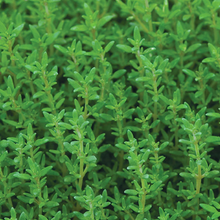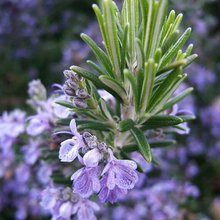Rosemary officinalis 'Salem' is a hardy upright rosemary cultivar known for its rich fragrance, intense flavor, and strong vertical habit. Unlike trailing types, 'Salem' maintains a dense shrubby form making it ideal for formal herb gardens or low hedging. Its needle like foliage is evergreen and pale blue flowers appear intermittently throughout the growing season attracting beneficial pollinators. It also tolerates humidity better than other rosemary types making it suitable for a wider range of climates.
Height & Spread: 24 - 36 in x 24 - 36 in
Bloom Time: Spring to fall, sporadically year round in warm zones
Light Requirements: Full sun
Soil Preference: Well drained, sandy or rocky soil
Watering Needs: Low; allow soil to dry between waterings
Deer Resistance: Strongly aromatic foliage deters deer and rabbits
Native Status
Native to the Mediterranean region, Rosemary officinalis 'Salem' is well adapted to dry sunny environments and is cultivated widely for culinary and ornamental purposes.
WILDLIFE & INSECTS
Bees
- Flowers are highly attractive to honeybees and native bees such as leafcutter and mason bees.
Butterflies
- Nectar rich blooms draw butterflies such as Painted Ladies and Common Buckeyes during active bloom cycles.
Beneficial Insects
- Provides a habitat and nectar source for predatory wasps and hoverflies, aiding in garden pest control.
Spacing & Landscape Use
Spacing Recommendations:
- Space 24 - 36 in apart to allow for air circulation and full mound development.
Landscape Placement:
- Use in herb gardens, borders, dry landscape beds, or containers. Also effective as a culinary edging plant.
Companion Plants
- Lavandula angustifolia 'Hidcote' - Shares sun and soil needs and its purple spikes contrast nicely with rosemary’s pale blue flowers.
- Salvia officinalis (Common Sage) - Complements rosemary in both growth habit and culinary utility while enhancing pollinator appeal.
- Allium schoenoprasum (Chives) - Adds edible texture and seasonal color with globe shaped purple blooms in early summer.
- Thymus vulgaris (English Thyme) - Low growing and mat forming thyme pairs well with rosemary’s upright form and shares water preferences.
- Origanum vulgare (Oregano) - Offers similar soil and sun needs and a flavorful aromatic contribution to herb plantings.



